Business Law Report: Negligence and Misrepresentation in Business
VerifiedAdded on 2019/10/30
|9
|2220
|249
Report
AI Summary
This report provides a comprehensive overview of business law in Australia, with a specific focus on economic torts, negligence, and misrepresentation. It defines torts and their relevance to business, particularly highlighting negligence and misrepresentation. The report delves into key concepts such as the duty of care, as established in cases like Donoghue v Stevenson and Oyston v St Patrick’s College, illustrating how negligence can affect businesses. It also examines misrepresentation, including its types and implications, using the Joystick Company Limited case as an example. The report further discusses the Australian Competition and Consumer Act 2010, emphasizing consumer rights and the guarantees provided under the Australian Consumer Law. It underscores the importance of businesses adhering to these laws to avoid unfair practices and protect consumers, offering insights into legal principles and practical applications in the Australian business environment. The report concludes by reinforcing the significance of businesses fulfilling their duty of care and providing accurate information to consumers.
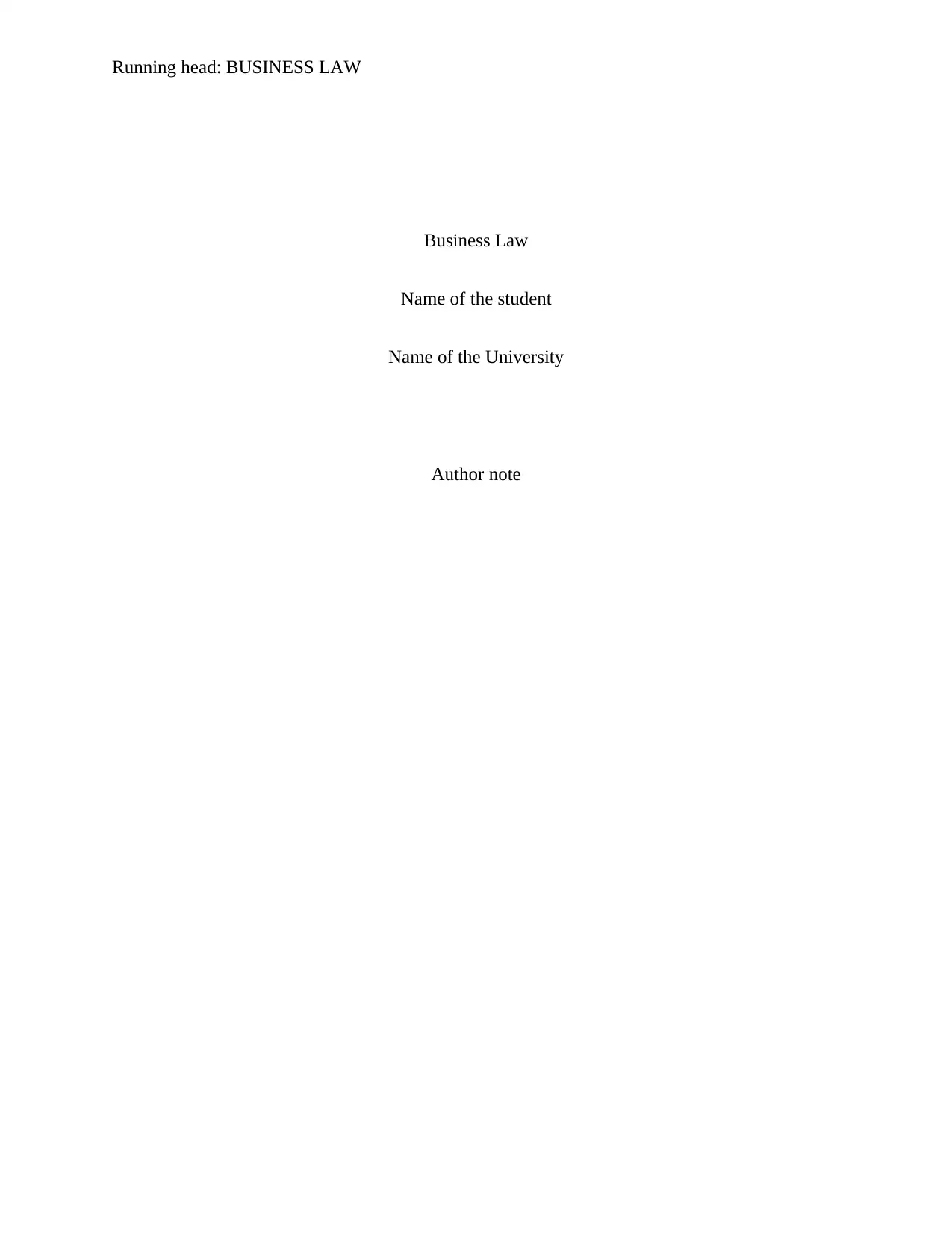
Running head: BUSINESS LAW
Business Law
Name of the student
Name of the University
Author note
Business Law
Name of the student
Name of the University
Author note
Paraphrase This Document
Need a fresh take? Get an instant paraphrase of this document with our AI Paraphraser
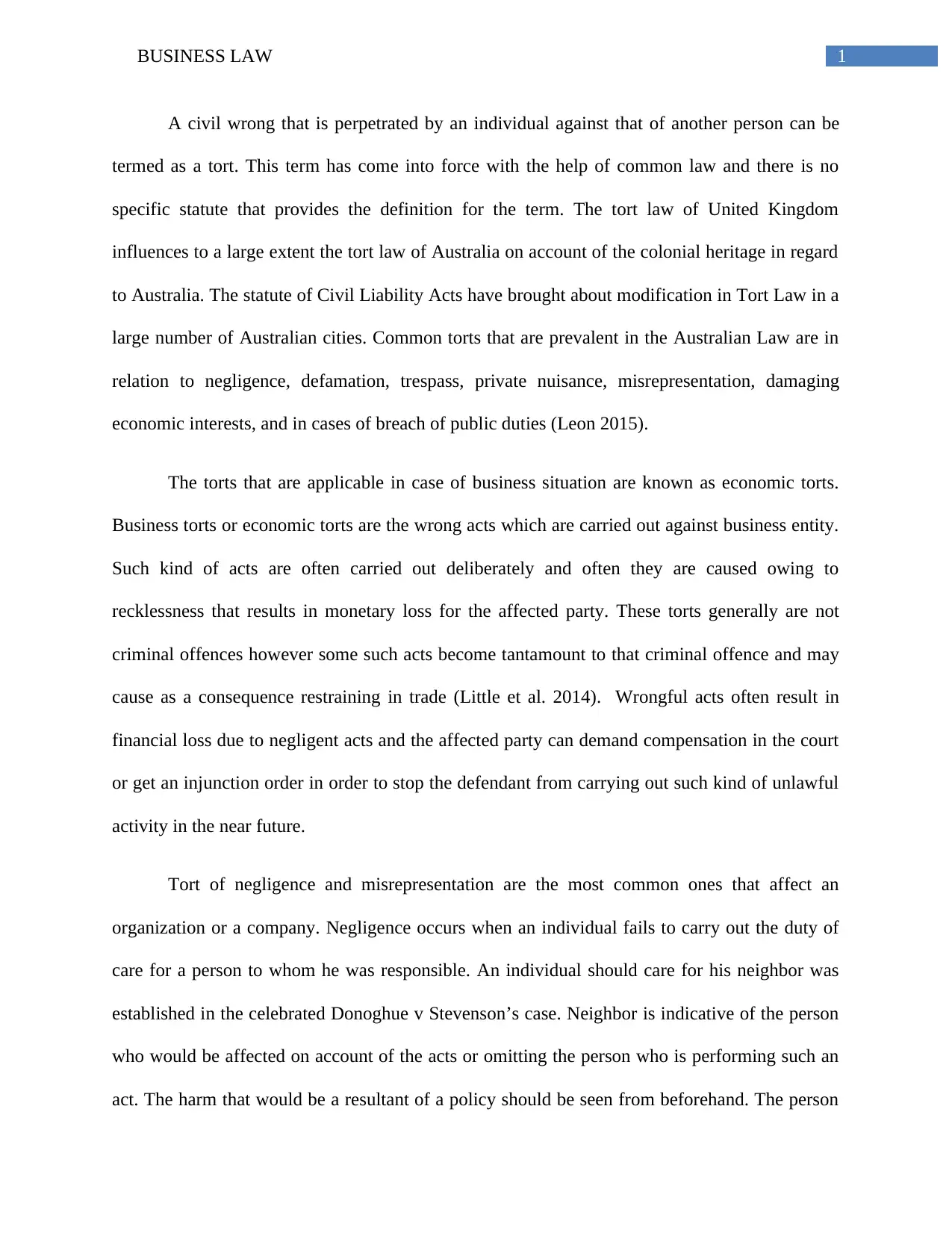
1BUSINESS LAW
A civil wrong that is perpetrated by an individual against that of another person can be
termed as a tort. This term has come into force with the help of common law and there is no
specific statute that provides the definition for the term. The tort law of United Kingdom
influences to a large extent the tort law of Australia on account of the colonial heritage in regard
to Australia. The statute of Civil Liability Acts have brought about modification in Tort Law in a
large number of Australian cities. Common torts that are prevalent in the Australian Law are in
relation to negligence, defamation, trespass, private nuisance, misrepresentation, damaging
economic interests, and in cases of breach of public duties (Leon 2015).
The torts that are applicable in case of business situation are known as economic torts.
Business torts or economic torts are the wrong acts which are carried out against business entity.
Such kind of acts are often carried out deliberately and often they are caused owing to
recklessness that results in monetary loss for the affected party. These torts generally are not
criminal offences however some such acts become tantamount to that criminal offence and may
cause as a consequence restraining in trade (Little et al. 2014). Wrongful acts often result in
financial loss due to negligent acts and the affected party can demand compensation in the court
or get an injunction order in order to stop the defendant from carrying out such kind of unlawful
activity in the near future.
Tort of negligence and misrepresentation are the most common ones that affect an
organization or a company. Negligence occurs when an individual fails to carry out the duty of
care for a person to whom he was responsible. An individual should care for his neighbor was
established in the celebrated Donoghue v Stevenson’s case. Neighbor is indicative of the person
who would be affected on account of the acts or omitting the person who is performing such an
act. The harm that would be a resultant of a policy should be seen from beforehand. The person
A civil wrong that is perpetrated by an individual against that of another person can be
termed as a tort. This term has come into force with the help of common law and there is no
specific statute that provides the definition for the term. The tort law of United Kingdom
influences to a large extent the tort law of Australia on account of the colonial heritage in regard
to Australia. The statute of Civil Liability Acts have brought about modification in Tort Law in a
large number of Australian cities. Common torts that are prevalent in the Australian Law are in
relation to negligence, defamation, trespass, private nuisance, misrepresentation, damaging
economic interests, and in cases of breach of public duties (Leon 2015).
The torts that are applicable in case of business situation are known as economic torts.
Business torts or economic torts are the wrong acts which are carried out against business entity.
Such kind of acts are often carried out deliberately and often they are caused owing to
recklessness that results in monetary loss for the affected party. These torts generally are not
criminal offences however some such acts become tantamount to that criminal offence and may
cause as a consequence restraining in trade (Little et al. 2014). Wrongful acts often result in
financial loss due to negligent acts and the affected party can demand compensation in the court
or get an injunction order in order to stop the defendant from carrying out such kind of unlawful
activity in the near future.
Tort of negligence and misrepresentation are the most common ones that affect an
organization or a company. Negligence occurs when an individual fails to carry out the duty of
care for a person to whom he was responsible. An individual should care for his neighbor was
established in the celebrated Donoghue v Stevenson’s case. Neighbor is indicative of the person
who would be affected on account of the acts or omitting the person who is performing such an
act. The harm that would be a resultant of a policy should be seen from beforehand. The person
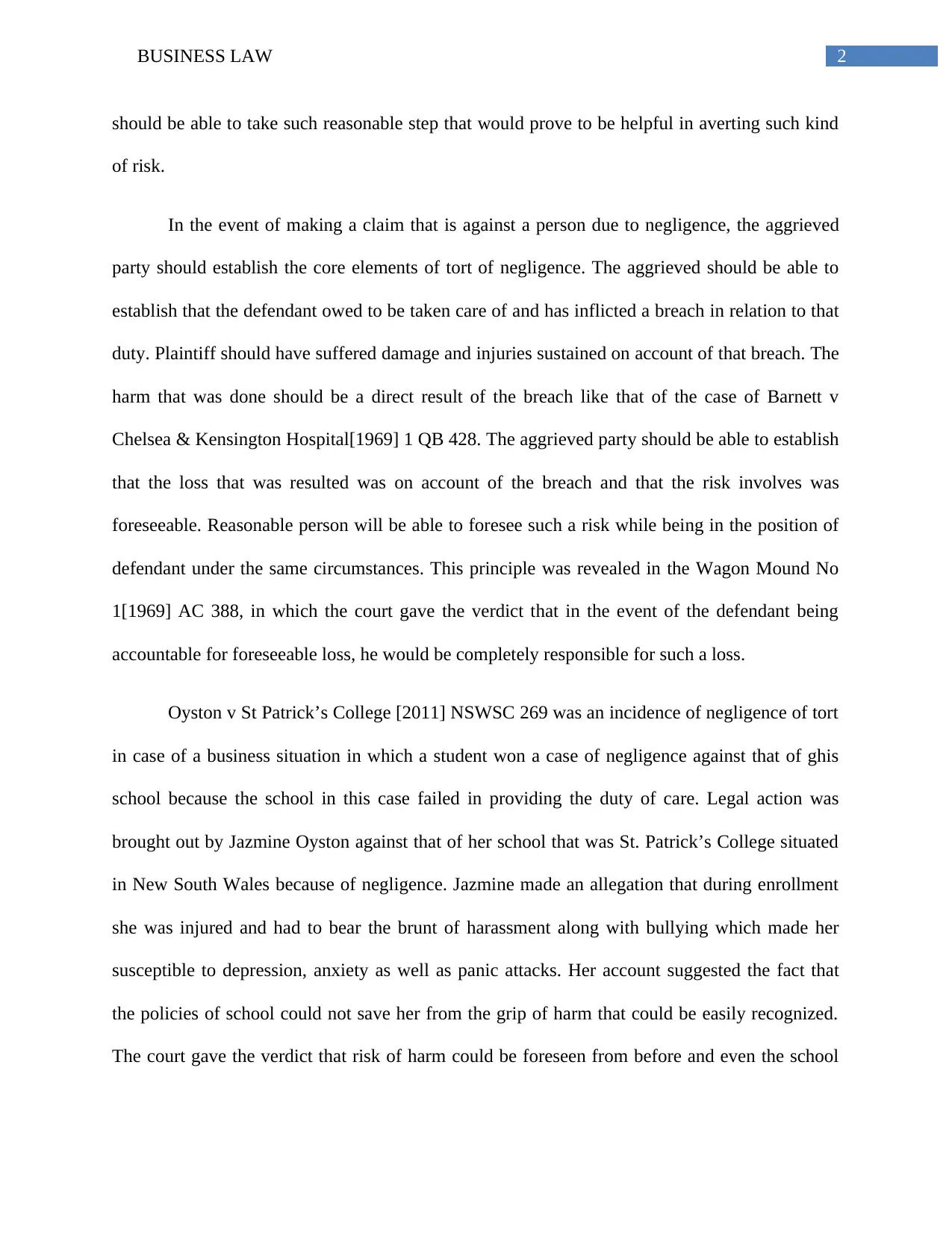
2BUSINESS LAW
should be able to take such reasonable step that would prove to be helpful in averting such kind
of risk.
In the event of making a claim that is against a person due to negligence, the aggrieved
party should establish the core elements of tort of negligence. The aggrieved should be able to
establish that the defendant owed to be taken care of and has inflicted a breach in relation to that
duty. Plaintiff should have suffered damage and injuries sustained on account of that breach. The
harm that was done should be a direct result of the breach like that of the case of Barnett v
Chelsea & Kensington Hospital[1969] 1 QB 428. The aggrieved party should be able to establish
that the loss that was resulted was on account of the breach and that the risk involves was
foreseeable. Reasonable person will be able to foresee such a risk while being in the position of
defendant under the same circumstances. This principle was revealed in the Wagon Mound No
1[1969] AC 388, in which the court gave the verdict that in the event of the defendant being
accountable for foreseeable loss, he would be completely responsible for such a loss.
Oyston v St Patrick’s College [2011] NSWSC 269 was an incidence of negligence of tort
in case of a business situation in which a student won a case of negligence against that of ghis
school because the school in this case failed in providing the duty of care. Legal action was
brought out by Jazmine Oyston against that of her school that was St. Patrick’s College situated
in New South Wales because of negligence. Jazmine made an allegation that during enrollment
she was injured and had to bear the brunt of harassment along with bullying which made her
susceptible to depression, anxiety as well as panic attacks. Her account suggested the fact that
the policies of school could not save her from the grip of harm that could be easily recognized.
The court gave the verdict that risk of harm could be foreseen from before and even the school
should be able to take such reasonable step that would prove to be helpful in averting such kind
of risk.
In the event of making a claim that is against a person due to negligence, the aggrieved
party should establish the core elements of tort of negligence. The aggrieved should be able to
establish that the defendant owed to be taken care of and has inflicted a breach in relation to that
duty. Plaintiff should have suffered damage and injuries sustained on account of that breach. The
harm that was done should be a direct result of the breach like that of the case of Barnett v
Chelsea & Kensington Hospital[1969] 1 QB 428. The aggrieved party should be able to establish
that the loss that was resulted was on account of the breach and that the risk involves was
foreseeable. Reasonable person will be able to foresee such a risk while being in the position of
defendant under the same circumstances. This principle was revealed in the Wagon Mound No
1[1969] AC 388, in which the court gave the verdict that in the event of the defendant being
accountable for foreseeable loss, he would be completely responsible for such a loss.
Oyston v St Patrick’s College [2011] NSWSC 269 was an incidence of negligence of tort
in case of a business situation in which a student won a case of negligence against that of ghis
school because the school in this case failed in providing the duty of care. Legal action was
brought out by Jazmine Oyston against that of her school that was St. Patrick’s College situated
in New South Wales because of negligence. Jazmine made an allegation that during enrollment
she was injured and had to bear the brunt of harassment along with bullying which made her
susceptible to depression, anxiety as well as panic attacks. Her account suggested the fact that
the policies of school could not save her from the grip of harm that could be easily recognized.
The court gave the verdict that risk of harm could be foreseen from before and even the school
⊘ This is a preview!⊘
Do you want full access?
Subscribe today to unlock all pages.

Trusted by 1+ million students worldwide
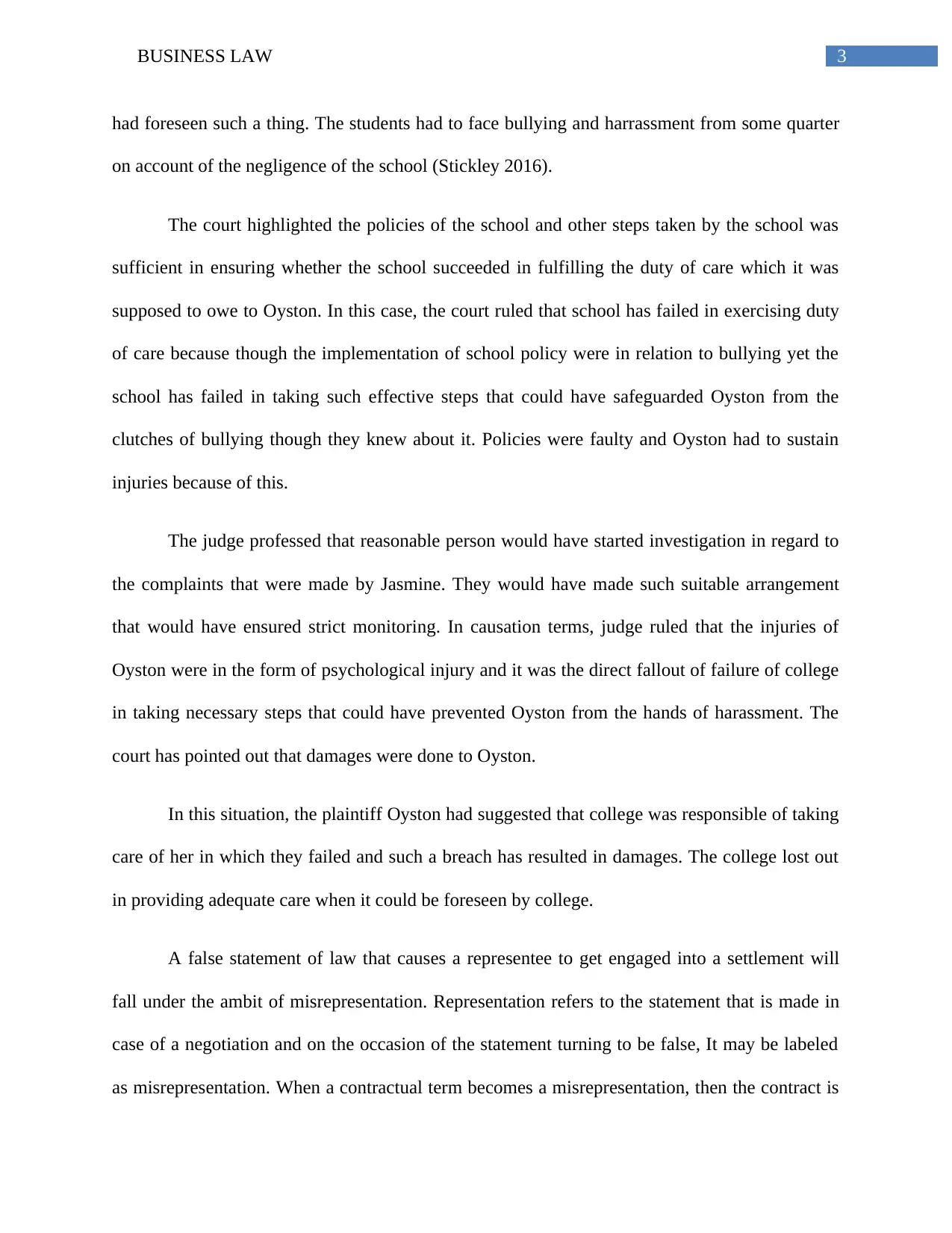
3BUSINESS LAW
had foreseen such a thing. The students had to face bullying and harrassment from some quarter
on account of the negligence of the school (Stickley 2016).
The court highlighted the policies of the school and other steps taken by the school was
sufficient in ensuring whether the school succeeded in fulfilling the duty of care which it was
supposed to owe to Oyston. In this case, the court ruled that school has failed in exercising duty
of care because though the implementation of school policy were in relation to bullying yet the
school has failed in taking such effective steps that could have safeguarded Oyston from the
clutches of bullying though they knew about it. Policies were faulty and Oyston had to sustain
injuries because of this.
The judge professed that reasonable person would have started investigation in regard to
the complaints that were made by Jasmine. They would have made such suitable arrangement
that would have ensured strict monitoring. In causation terms, judge ruled that the injuries of
Oyston were in the form of psychological injury and it was the direct fallout of failure of college
in taking necessary steps that could have prevented Oyston from the hands of harassment. The
court has pointed out that damages were done to Oyston.
In this situation, the plaintiff Oyston had suggested that college was responsible of taking
care of her in which they failed and such a breach has resulted in damages. The college lost out
in providing adequate care when it could be foreseen by college.
A false statement of law that causes a representee to get engaged into a settlement will
fall under the ambit of misrepresentation. Representation refers to the statement that is made in
case of a negotiation and on the occasion of the statement turning to be false, It may be labeled
as misrepresentation. When a contractual term becomes a misrepresentation, then the contract is
had foreseen such a thing. The students had to face bullying and harrassment from some quarter
on account of the negligence of the school (Stickley 2016).
The court highlighted the policies of the school and other steps taken by the school was
sufficient in ensuring whether the school succeeded in fulfilling the duty of care which it was
supposed to owe to Oyston. In this case, the court ruled that school has failed in exercising duty
of care because though the implementation of school policy were in relation to bullying yet the
school has failed in taking such effective steps that could have safeguarded Oyston from the
clutches of bullying though they knew about it. Policies were faulty and Oyston had to sustain
injuries because of this.
The judge professed that reasonable person would have started investigation in regard to
the complaints that were made by Jasmine. They would have made such suitable arrangement
that would have ensured strict monitoring. In causation terms, judge ruled that the injuries of
Oyston were in the form of psychological injury and it was the direct fallout of failure of college
in taking necessary steps that could have prevented Oyston from the hands of harassment. The
court has pointed out that damages were done to Oyston.
In this situation, the plaintiff Oyston had suggested that college was responsible of taking
care of her in which they failed and such a breach has resulted in damages. The college lost out
in providing adequate care when it could be foreseen by college.
A false statement of law that causes a representee to get engaged into a settlement will
fall under the ambit of misrepresentation. Representation refers to the statement that is made in
case of a negotiation and on the occasion of the statement turning to be false, It may be labeled
as misrepresentation. When a contractual term becomes a misrepresentation, then the contract is
Paraphrase This Document
Need a fresh take? Get an instant paraphrase of this document with our AI Paraphraser
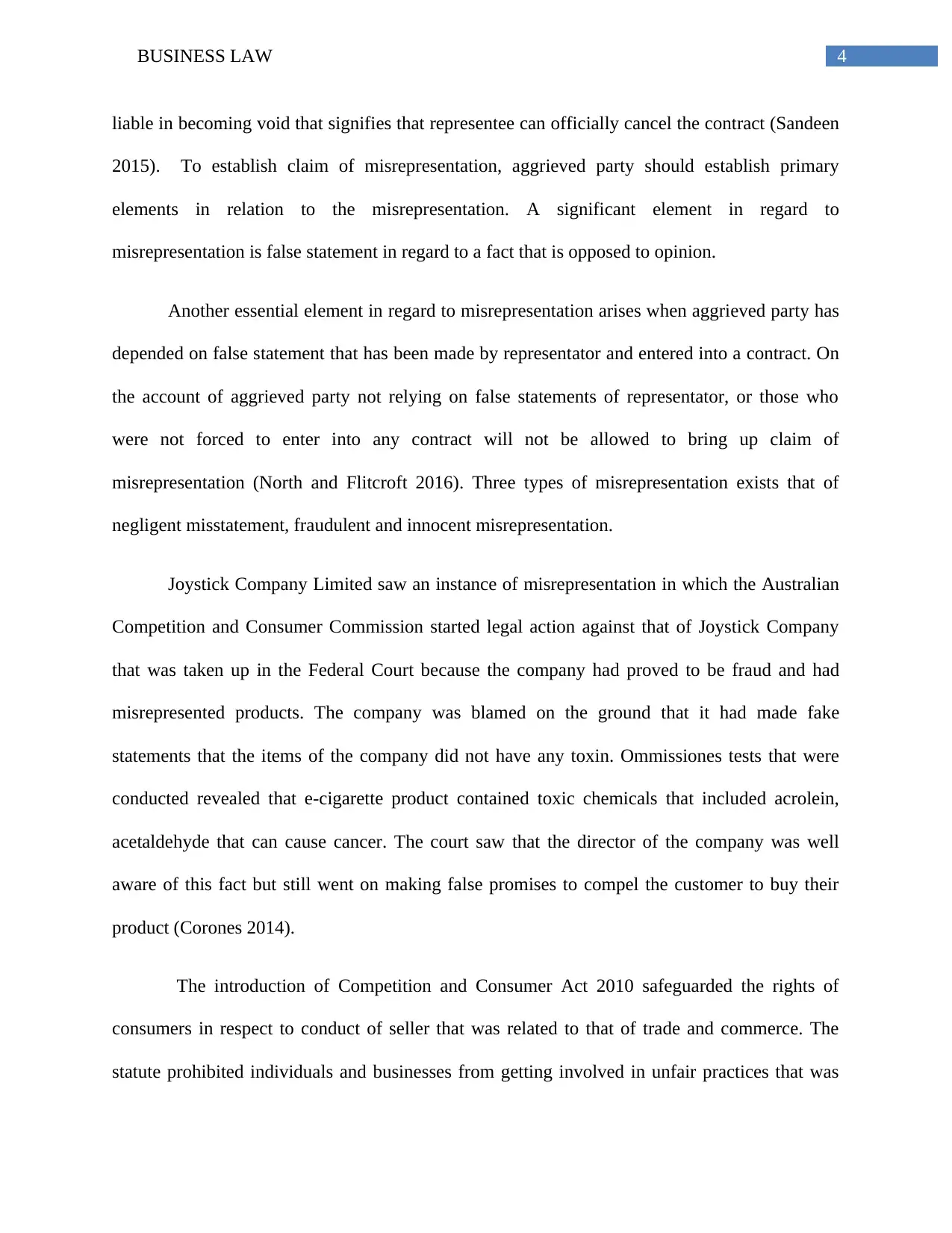
4BUSINESS LAW
liable in becoming void that signifies that representee can officially cancel the contract (Sandeen
2015). To establish claim of misrepresentation, aggrieved party should establish primary
elements in relation to the misrepresentation. A significant element in regard to
misrepresentation is false statement in regard to a fact that is opposed to opinion.
Another essential element in regard to misrepresentation arises when aggrieved party has
depended on false statement that has been made by representator and entered into a contract. On
the account of aggrieved party not relying on false statements of representator, or those who
were not forced to enter into any contract will not be allowed to bring up claim of
misrepresentation (North and Flitcroft 2016). Three types of misrepresentation exists that of
negligent misstatement, fraudulent and innocent misrepresentation.
Joystick Company Limited saw an instance of misrepresentation in which the Australian
Competition and Consumer Commission started legal action against that of Joystick Company
that was taken up in the Federal Court because the company had proved to be fraud and had
misrepresented products. The company was blamed on the ground that it had made fake
statements that the items of the company did not have any toxin. Ommissiones tests that were
conducted revealed that e-cigarette product contained toxic chemicals that included acrolein,
acetaldehyde that can cause cancer. The court saw that the director of the company was well
aware of this fact but still went on making false promises to compel the customer to buy their
product (Corones 2014).
The introduction of Competition and Consumer Act 2010 safeguarded the rights of
consumers in respect to conduct of seller that was related to that of trade and commerce. The
statute prohibited individuals and businesses from getting involved in unfair practices that was
liable in becoming void that signifies that representee can officially cancel the contract (Sandeen
2015). To establish claim of misrepresentation, aggrieved party should establish primary
elements in relation to the misrepresentation. A significant element in regard to
misrepresentation is false statement in regard to a fact that is opposed to opinion.
Another essential element in regard to misrepresentation arises when aggrieved party has
depended on false statement that has been made by representator and entered into a contract. On
the account of aggrieved party not relying on false statements of representator, or those who
were not forced to enter into any contract will not be allowed to bring up claim of
misrepresentation (North and Flitcroft 2016). Three types of misrepresentation exists that of
negligent misstatement, fraudulent and innocent misrepresentation.
Joystick Company Limited saw an instance of misrepresentation in which the Australian
Competition and Consumer Commission started legal action against that of Joystick Company
that was taken up in the Federal Court because the company had proved to be fraud and had
misrepresented products. The company was blamed on the ground that it had made fake
statements that the items of the company did not have any toxin. Ommissiones tests that were
conducted revealed that e-cigarette product contained toxic chemicals that included acrolein,
acetaldehyde that can cause cancer. The court saw that the director of the company was well
aware of this fact but still went on making false promises to compel the customer to buy their
product (Corones 2014).
The introduction of Competition and Consumer Act 2010 safeguarded the rights of
consumers in respect to conduct of seller that was related to that of trade and commerce. The
statute prohibited individuals and businesses from getting involved in unfair practices that was
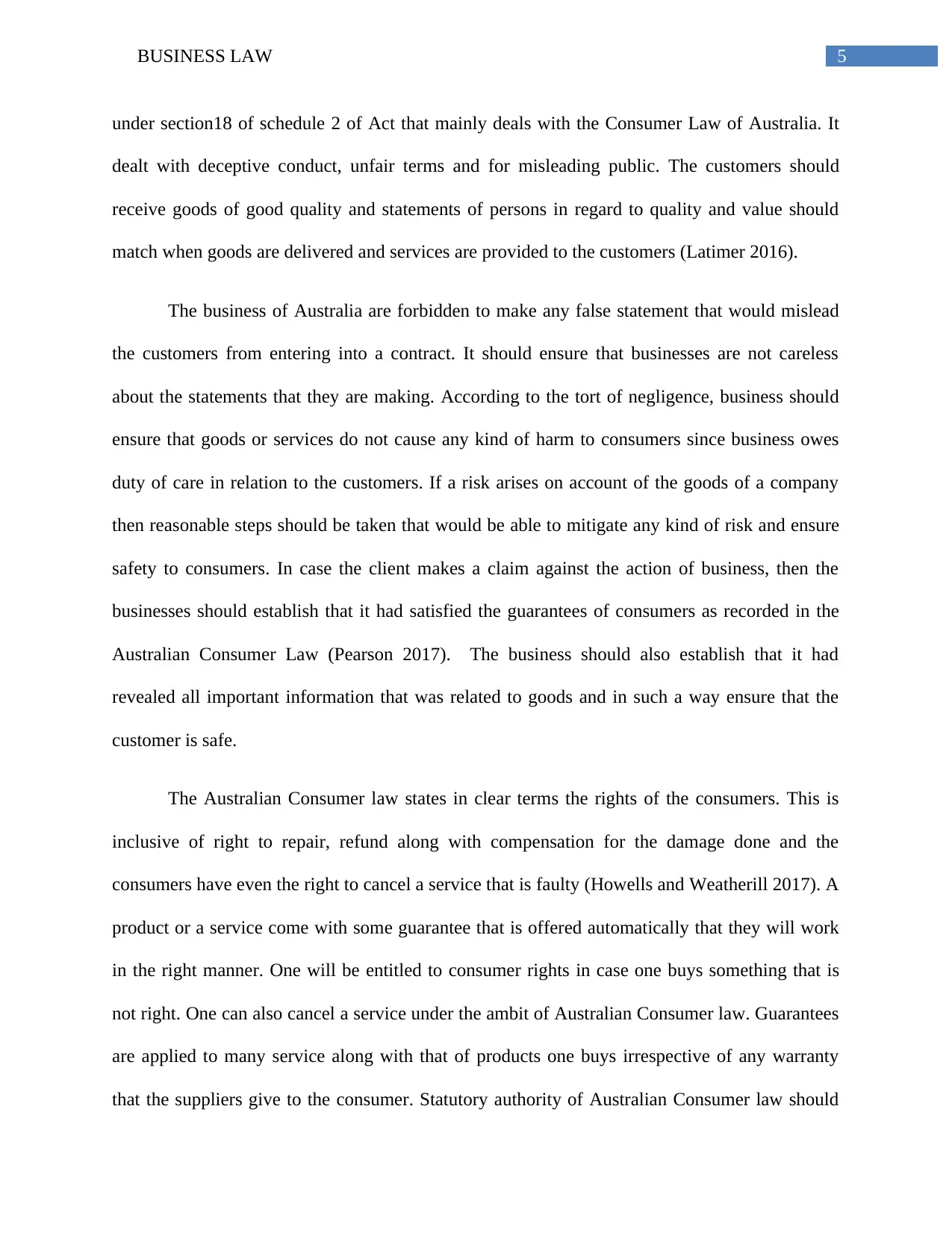
5BUSINESS LAW
under section18 of schedule 2 of Act that mainly deals with the Consumer Law of Australia. It
dealt with deceptive conduct, unfair terms and for misleading public. The customers should
receive goods of good quality and statements of persons in regard to quality and value should
match when goods are delivered and services are provided to the customers (Latimer 2016).
The business of Australia are forbidden to make any false statement that would mislead
the customers from entering into a contract. It should ensure that businesses are not careless
about the statements that they are making. According to the tort of negligence, business should
ensure that goods or services do not cause any kind of harm to consumers since business owes
duty of care in relation to the customers. If a risk arises on account of the goods of a company
then reasonable steps should be taken that would be able to mitigate any kind of risk and ensure
safety to consumers. In case the client makes a claim against the action of business, then the
businesses should establish that it had satisfied the guarantees of consumers as recorded in the
Australian Consumer Law (Pearson 2017). The business should also establish that it had
revealed all important information that was related to goods and in such a way ensure that the
customer is safe.
The Australian Consumer law states in clear terms the rights of the consumers. This is
inclusive of right to repair, refund along with compensation for the damage done and the
consumers have even the right to cancel a service that is faulty (Howells and Weatherill 2017). A
product or a service come with some guarantee that is offered automatically that they will work
in the right manner. One will be entitled to consumer rights in case one buys something that is
not right. One can also cancel a service under the ambit of Australian Consumer law. Guarantees
are applied to many service along with that of products one buys irrespective of any warranty
that the suppliers give to the consumer. Statutory authority of Australian Consumer law should
under section18 of schedule 2 of Act that mainly deals with the Consumer Law of Australia. It
dealt with deceptive conduct, unfair terms and for misleading public. The customers should
receive goods of good quality and statements of persons in regard to quality and value should
match when goods are delivered and services are provided to the customers (Latimer 2016).
The business of Australia are forbidden to make any false statement that would mislead
the customers from entering into a contract. It should ensure that businesses are not careless
about the statements that they are making. According to the tort of negligence, business should
ensure that goods or services do not cause any kind of harm to consumers since business owes
duty of care in relation to the customers. If a risk arises on account of the goods of a company
then reasonable steps should be taken that would be able to mitigate any kind of risk and ensure
safety to consumers. In case the client makes a claim against the action of business, then the
businesses should establish that it had satisfied the guarantees of consumers as recorded in the
Australian Consumer Law (Pearson 2017). The business should also establish that it had
revealed all important information that was related to goods and in such a way ensure that the
customer is safe.
The Australian Consumer law states in clear terms the rights of the consumers. This is
inclusive of right to repair, refund along with compensation for the damage done and the
consumers have even the right to cancel a service that is faulty (Howells and Weatherill 2017). A
product or a service come with some guarantee that is offered automatically that they will work
in the right manner. One will be entitled to consumer rights in case one buys something that is
not right. One can also cancel a service under the ambit of Australian Consumer law. Guarantees
are applied to many service along with that of products one buys irrespective of any warranty
that the suppliers give to the consumer. Statutory authority of Australian Consumer law should
⊘ This is a preview!⊘
Do you want full access?
Subscribe today to unlock all pages.

Trusted by 1+ million students worldwide
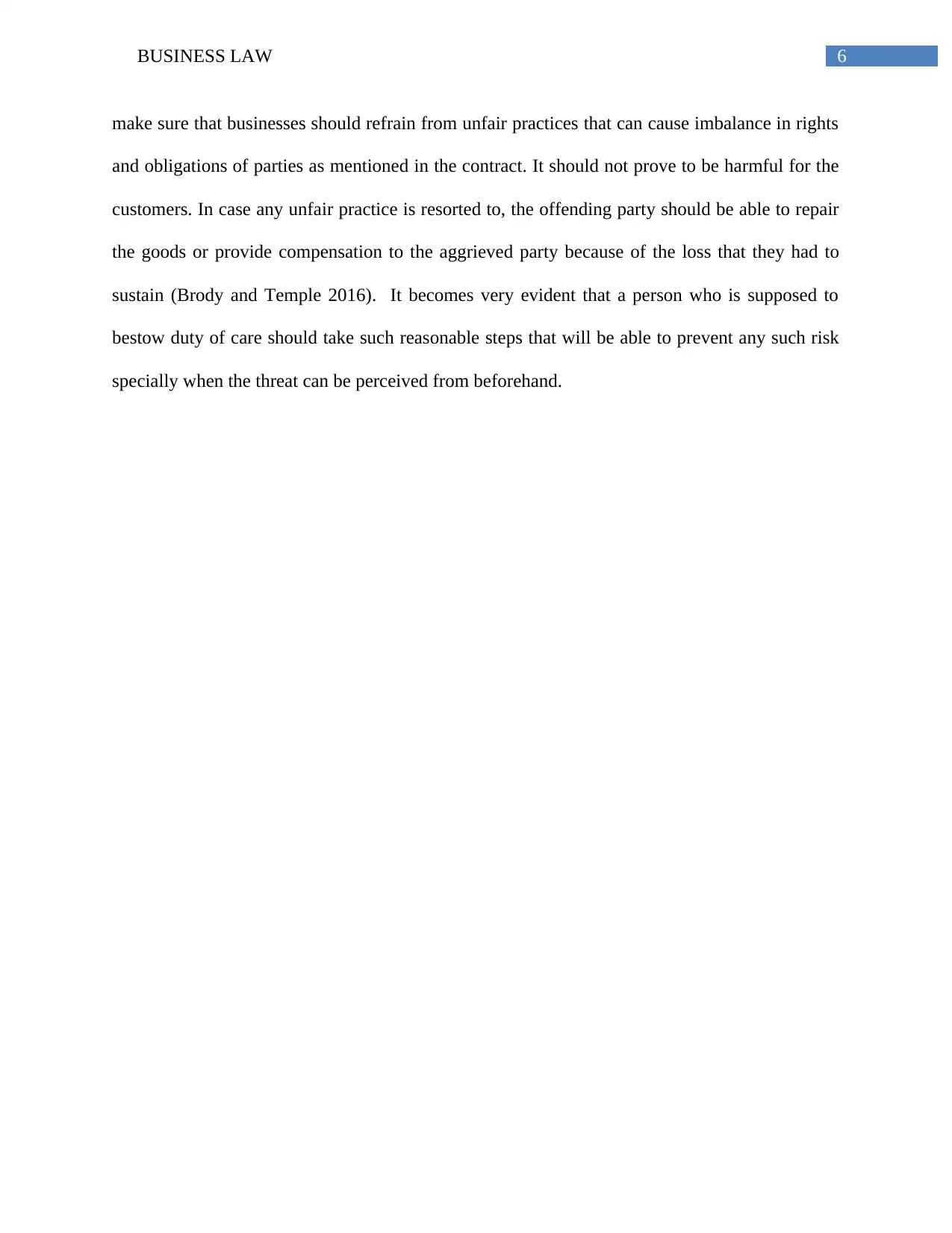
6BUSINESS LAW
make sure that businesses should refrain from unfair practices that can cause imbalance in rights
and obligations of parties as mentioned in the contract. It should not prove to be harmful for the
customers. In case any unfair practice is resorted to, the offending party should be able to repair
the goods or provide compensation to the aggrieved party because of the loss that they had to
sustain (Brody and Temple 2016). It becomes very evident that a person who is supposed to
bestow duty of care should take such reasonable steps that will be able to prevent any such risk
specially when the threat can be perceived from beforehand.
make sure that businesses should refrain from unfair practices that can cause imbalance in rights
and obligations of parties as mentioned in the contract. It should not prove to be harmful for the
customers. In case any unfair practice is resorted to, the offending party should be able to repair
the goods or provide compensation to the aggrieved party because of the loss that they had to
sustain (Brody and Temple 2016). It becomes very evident that a person who is supposed to
bestow duty of care should take such reasonable steps that will be able to prevent any such risk
specially when the threat can be perceived from beforehand.
Paraphrase This Document
Need a fresh take? Get an instant paraphrase of this document with our AI Paraphraser
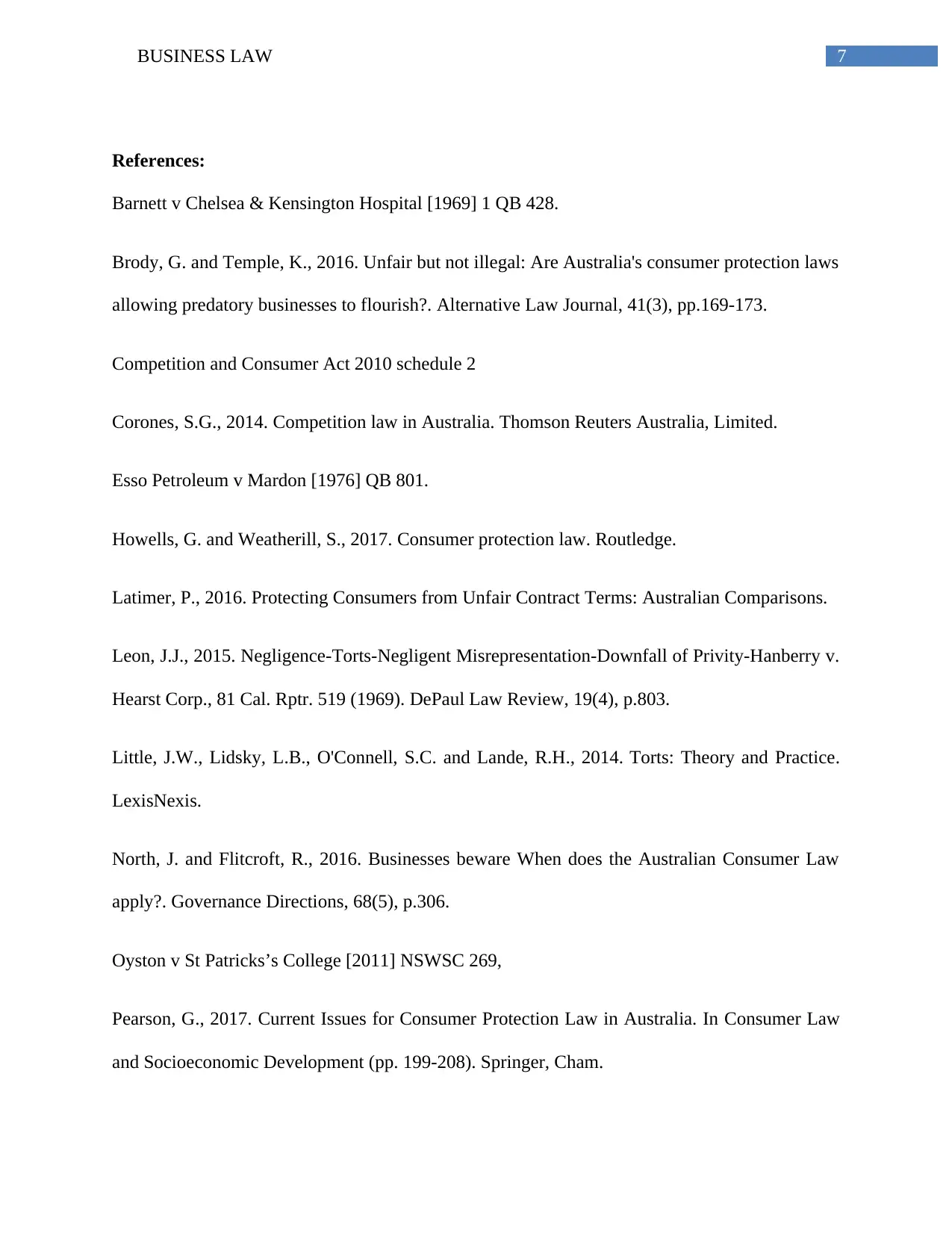
7BUSINESS LAW
References:
Barnett v Chelsea & Kensington Hospital [1969] 1 QB 428.
Brody, G. and Temple, K., 2016. Unfair but not illegal: Are Australia's consumer protection laws
allowing predatory businesses to flourish?. Alternative Law Journal, 41(3), pp.169-173.
Competition and Consumer Act 2010 schedule 2
Corones, S.G., 2014. Competition law in Australia. Thomson Reuters Australia, Limited.
Esso Petroleum v Mardon [1976] QB 801.
Howells, G. and Weatherill, S., 2017. Consumer protection law. Routledge.
Latimer, P., 2016. Protecting Consumers from Unfair Contract Terms: Australian Comparisons.
Leon, J.J., 2015. Negligence-Torts-Negligent Misrepresentation-Downfall of Privity-Hanberry v.
Hearst Corp., 81 Cal. Rptr. 519 (1969). DePaul Law Review, 19(4), p.803.
Little, J.W., Lidsky, L.B., O'Connell, S.C. and Lande, R.H., 2014. Torts: Theory and Practice.
LexisNexis.
North, J. and Flitcroft, R., 2016. Businesses beware When does the Australian Consumer Law
apply?. Governance Directions, 68(5), p.306.
Oyston v St Patricks’s College [2011] NSWSC 269,
Pearson, G., 2017. Current Issues for Consumer Protection Law in Australia. In Consumer Law
and Socioeconomic Development (pp. 199-208). Springer, Cham.
References:
Barnett v Chelsea & Kensington Hospital [1969] 1 QB 428.
Brody, G. and Temple, K., 2016. Unfair but not illegal: Are Australia's consumer protection laws
allowing predatory businesses to flourish?. Alternative Law Journal, 41(3), pp.169-173.
Competition and Consumer Act 2010 schedule 2
Corones, S.G., 2014. Competition law in Australia. Thomson Reuters Australia, Limited.
Esso Petroleum v Mardon [1976] QB 801.
Howells, G. and Weatherill, S., 2017. Consumer protection law. Routledge.
Latimer, P., 2016. Protecting Consumers from Unfair Contract Terms: Australian Comparisons.
Leon, J.J., 2015. Negligence-Torts-Negligent Misrepresentation-Downfall of Privity-Hanberry v.
Hearst Corp., 81 Cal. Rptr. 519 (1969). DePaul Law Review, 19(4), p.803.
Little, J.W., Lidsky, L.B., O'Connell, S.C. and Lande, R.H., 2014. Torts: Theory and Practice.
LexisNexis.
North, J. and Flitcroft, R., 2016. Businesses beware When does the Australian Consumer Law
apply?. Governance Directions, 68(5), p.306.
Oyston v St Patricks’s College [2011] NSWSC 269,
Pearson, G., 2017. Current Issues for Consumer Protection Law in Australia. In Consumer Law
and Socioeconomic Development (pp. 199-208). Springer, Cham.
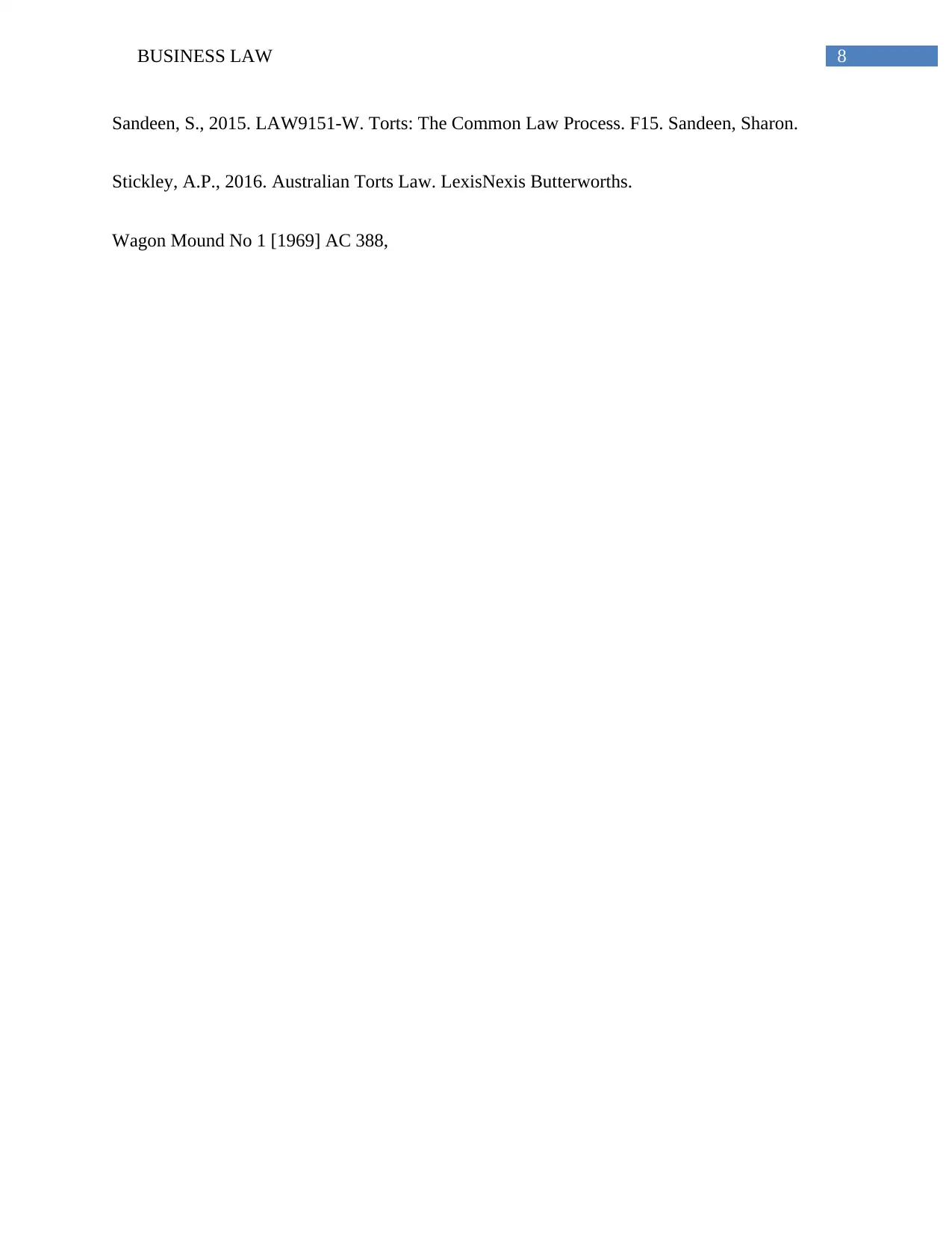
8BUSINESS LAW
Sandeen, S., 2015. LAW9151-W. Torts: The Common Law Process. F15. Sandeen, Sharon.
Stickley, A.P., 2016. Australian Torts Law. LexisNexis Butterworths.
Wagon Mound No 1 [1969] AC 388,
Sandeen, S., 2015. LAW9151-W. Torts: The Common Law Process. F15. Sandeen, Sharon.
Stickley, A.P., 2016. Australian Torts Law. LexisNexis Butterworths.
Wagon Mound No 1 [1969] AC 388,
⊘ This is a preview!⊘
Do you want full access?
Subscribe today to unlock all pages.

Trusted by 1+ million students worldwide
1 out of 9
Related Documents
Your All-in-One AI-Powered Toolkit for Academic Success.
+13062052269
info@desklib.com
Available 24*7 on WhatsApp / Email
![[object Object]](/_next/static/media/star-bottom.7253800d.svg)
Unlock your academic potential
Copyright © 2020–2025 A2Z Services. All Rights Reserved. Developed and managed by ZUCOL.





